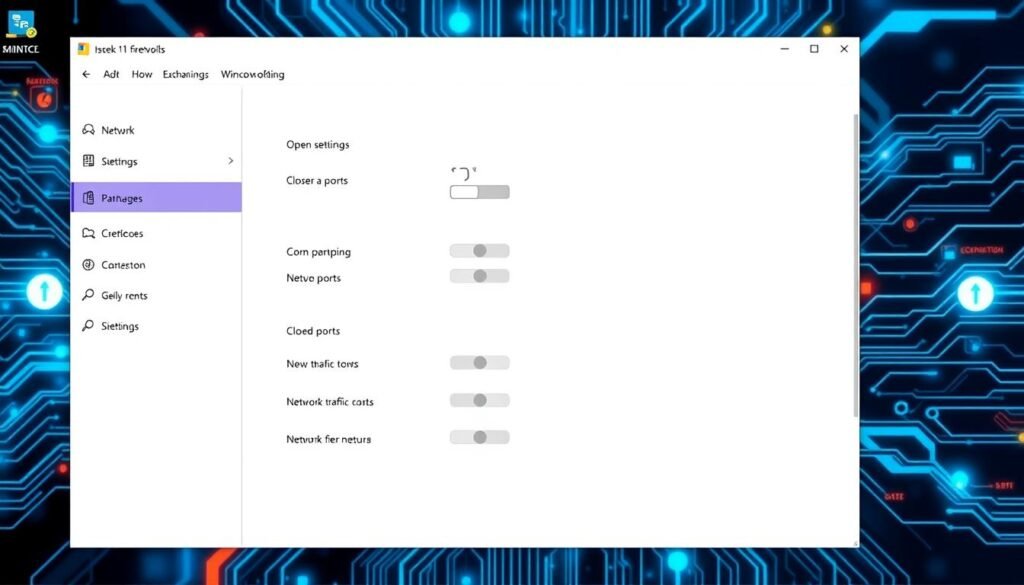Are you having trouble with your network or apps not working right? Opening ports in Windows 11 Command Prompt can be tough. It’s especially hard with how fast things change in network management.
I know how annoying it is to deal with connection problems that might be from blocked ports. But don’t worry, I’m here to help. This article will show you how to Open Ports Command Prompt Windows 11 easily, fix connection issues, and keep your system safe on Windows 11. By the end, you’ll know how to handle your network tasks better.
Key Takeaways
- Understand the role of ports in network communication.
- Learn how to access Command Prompt for port management.
- Utilize essential commands like netstat to monitor open ports.
- Identify applications using specific ports for effective troubleshooting.
- Explore features of third-party tools like CurrPorts for easier management.
- Implement regular checks to secure your network against vulnerabilities.
Table of Contents
Understanding Network Ports
Network ports are like the guards of the internet. They use numbers to sort out who gets what data. This makes sure everything gets to where it needs to go smoothly.
What Are Network Ports?
Ports are divided into three main groups. Well-known ports (0-1023) are for important stuff. Registered ports (1024-49151) are for regular use. Dynamic ports (49152-65535) are for temporary needs.
Each port has its own job. TCP and UDP ports are key for different tasks. TCP is for reliable connections, while UDP is for quick, no-wait service.
The Importance of Ports in Communication
Knowing about network ports is crucial for good network communication. The right ports help apps work well and keep the network safe. It’s also important to watch for problems to fix them fast.
Tools like netstat help find open ports and weak spots. By keeping an eye on ports, you can protect your system from harm.
How Ports Work in Networking
Ports are key in networks for smooth communication. Each device has an IP address. Ports help data reach the right apps on that device. This setup is vital for the internet to work well.
The Role of IP Addresses and Ports
IP addresses help devices talk to each other. Ports guide data to the right apps. Knowing how they work together is important for good network flow.
Types of Ports: TCP and UDP
There are two main port types: TCP and UDP. Each has its own job in sending data:
| Port Type | Features | Use Cases |
|---|---|---|
| TCP Ports | Connection-oriented, ensures reliable data transfer | Web browsing (HTTP), file transfers (FTP) |
| UDP Ports | Connectionless, faster but less reliable | Streaming media, online gaming |
Knowing about TCP and UDP ports is useful. It helps make networks faster and more reliable.
Using Command Prompt to Manage Ports
Managing ports well needs access to the command prompt in Windows 11. With admin rights, I can use important CMD commands. These help me manage ports well. I’ll show you how to get to Command Prompt as an admin and the key CMD commands for port tasks.
Accessing Command Prompt as an Administrator
To manage ports, I first need to get to Command Prompt with admin rights. I do this by right-clicking on the Start menu, looking for “Command Prompt,” and choosing “Run as administrator.” This makes sure I can run commands that change network settings.
Essential CMD Commands for Port Management
In the command prompt, I use several CMD commands for port management:
- netstat -ab – This command shows active connections and the apps they’re with. It helps me see how services use open ports.
- netsh advfirewall firewall add rule – I use this to make rules for incoming traffic on specific ports. It helps keep some traffic safe while letting others in.
- netsh interface portproxy add – This command is great for sending incoming traffic from one port to another. For example, it can send traffic from TCP port 3340 to local port 3389 for remote desktop.
The table below shows these important commands for easy use:
| CMD Command | Description |
|---|---|
| netstat -ab | List active connections with associated applications. |
| netsh advfirewall firewall add rule | Create inbound rules for specific ports. |
| netsh interface portproxy add | Redirect incoming traffic from one port to another. |
Learning these CMD commands helps me manage ports in Windows 11 better.
How to Open Ports Command Prompt Windows 11
Opening ports in Windows 11 using Command Prompt is key for better app connection. It’s vital for web servers or trading platforms. Here’s a guide on how to do it, including common ports to watch.
Step-by-Step Guide to Opening Ports
To start, go to Windows Defender Firewall and click Advanced Settings. Follow these steps:
- Open Control Panel and pick Windows Defender Firewall.
- Click on Advanced settings.
- In the left panel, choose Inbound Rules.
- On the right, pick New Rule.
- Choose Port and click Next.
- Enter the port number or range, like 80 or 443, and click Next.
- Select Allow the connection, then click Next.
- Pick the network profiles (Domain, Private, Public) the rule will apply to, and click Next.
- Lastly, name the rule, like “HTTP Port”, and click Finish.
Examples of Common Ports to Open
Many common ports are used for different apps. Knowing which to open can boost performance:
| Port Number | Application/Service | Protocol |
|---|---|---|
| 80 | HTTP | TCP |
| 443 | HTTPS | TCP |
| 21 | FTP | TCP |
| 22 | SSH | TCP |
| 9997 | Trading Platforms | TCP |
Knowing how to open ports in Windows 11 can greatly improve app performance. By knowing common ports and following the right steps, you can optimize your network.
Checking Open Ports in Windows 11
Managing open ports is key for network security and efficiency. In Windows 11, tools like netstat help check open ports. Netstat gives detailed info on active connections and the processes using them.
Using Built-In Tools: netstat Command
The netstat command is great for checking open ports. It shows TCP and UDP ports, which are important for network communication. Running netstat -ab tells you which apps use open ports and their status.
Identifying Processes Using Specific Ports
With netstat -aon, you can see port status and process IDs. This helps spot processes on certain ports, which can be risky. Tools like CurrPorts also monitor open ports in real-time, showing process names and more.
Windows 11 has 65,535 TCP and UDP ports. Knowing how to check and manage these ports is crucial. Regular use of these tools keeps your network safe and secure.
Firewall Settings and Port Management

Managing open ports is key for smooth app use without security risks. The Windows Defender Firewall is vital for this. It helps set inbound rules for how traffic uses my system’s open ports.
Configuring Windows Defender Firewall
I start by going to Firewall settings in the Control Panel. Here, I can make inbound rules for my system. For example, to open port 80 for HTTP, I follow these steps:
- Select Advanced Settings
- Click on Inbound Rules
- Create a New Rule
- Choose Port as the rule type
- Select TCP as the protocol
- Specify Local Port as 80
- Allow the connection
After setting up the rules, I make sure users can access the report server. This includes setting roles at the Home and Site levels. Then, I restart my computer to apply the changes.
Creating Inbound Rules for Open Ports
Windows Defender Firewall lets me fine-tune inbound rules. I use tools like PowerShell for advanced management. This gives me better control over network ports.
Checking my opened ports with netstat -ano is very helpful. This command shows all used ports and their PIDs. To check my settings from outside, I test the web portal from another computer.
Keeping Windows Defender Firewall on is important. Microsoft warns against turning it off. It can cause problems with the start menu or app performance.
Network Port Forwarding Basics
Learning about network port forwarding is key for better network use. It lets incoming traffic go to a specific device on your network. This helps apps like online games and remote work run smoother.
What is Port Forwarding?
Port forwarding lets outside networks talk to your private network devices. It makes a special path through your router. This way, apps and devices get data without the router’s firewall blocking it.
It’s often used by web and FTP server hosts. They need it to work well.
Configuring Router Settings for Port Forwarding
To set up port forwarding, I go to my router’s settings in a web browser. Here’s what I do:
- I find the router’s IP address.
- I log in with admin details.
- I go to the Port Forwarding section.
- I enter the service’s name, type, port numbers, and device IP.
- Then, I save the changes.
Many routers have different settings for this. Some even have menus for common apps. This makes it easier.
But, port forwarding can also risk your network. It’s important to set up IP addresses and port numbers right. Wrong settings can cause problems or make your network vulnerable.
For Windows, using the Windows Firewall helps manage these settings well.
Network Troubleshooting with Open Ports
When you have trouble connecting, it’s key to troubleshoot your network. Knowing how to find open ports helps a lot. With the right tools, you can find and fix network problems fast.
Diagnosing Connection Issues
Fixing connection problems needs a clear plan. Start with the Ping command to see if devices talk to each other. If you get errors, like “Destination host unreachable,” you need to dig deeper.
- Step 1: Capture a network diagram including devices like firewalls, IPS, DPI, and WAN accelerators.
- Step 2: Check for issues affecting specific destination nodes.
- Step 3: Troubleshoot network adapter problems and reset IP and Winsock settings.
- Step 4: Use Telnet and PsPing to check application-level connectivity via TCP or UDP.
- Step 5: Test ping or Telnet to the default gateway for external connectivity status.
Tools for Effective Network Troubleshooting
Looking at open ports helps a lot. The netstat command shows which ports are open. Using netstat -an | find “LISTEN” helps manage your network better.
Common problems can slow down your network. For example:
| Issue | Description |
|---|---|
| TCP/IP connection issues | Data blocking in TCP and UDP queues or software delays at the network/user level. |
| Lmhosts file parsing errors | Misconfigurations that can cause connectivity interruptions. |
Keeping an eye on ports helps keep your network safe. With a careful plan and the right tools, you can solve port problems quickly.
Conclusion
Managing open ports in Windows 11 with the command prompt is key for safe network use. I now know how to manage ports, fix problems, and set up for the best app performance. This helps me keep my online space safe and secure.
It’s important to only open needed ports, especially on a VPS. This reduces risk of attacks. Using strong passwords and good security keeps my VPS safe from threats. Watching my VPS for odd activity helps me catch security issues fast.
In short, using the command prompt to open ports makes my server work better and keeps my network safe. As I keep up with managing ports in Windows 11, I make sure users have a smooth experience. I also protect my digital stuff. Following these network management tips helps me handle today’s digital world with confidence.






0 Comments